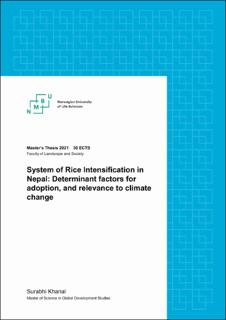| dc.description.abstract | Until the year 1985, Nepal used to be a net exporter of rice. During the 1960s, Nepal was exporting rice worth [u.s.dollar]45 million to India, annually. Compared to the current times, in the year 2015, Nepal imported rice worth [u.s.dollar]210 million from India. Decrease in land availability for agricultural production. The country faces major challenges in rice production, such as low productivity, low soil fertility, land degradation, and climate change impacts. The System of Rice Intensification, an alternative rice production technique offers a sustainable solution to all these challenges. The System of Rice Intensification as a new agricultural innovation has been disseminated in Nepal, since the trials began in 1999. SRI is an agro-ecological methodology to increase the productivity of irrigated rice. The productivity of rice is increased by changing the management of water, soil, plants, and nutrients. However, since the majority of Nepalese farmers are accustomed to conventional rice farming methods, the adoption of SRI is taking a slow lane. The objectives of this thesis was to a) the adoption behavior of the farmers concerning the determinant factors of SRI adoption and b) compare(to conventional system) and potential environmental benefits of SRI in the context of climate change. I analysed the findings by making use of the Agriculture Innovation System Approach and Adoption and Diffusion theory. Concerning research design, this research is qualitative in nature. Both, primary sources and secondary sources were used for data collection purposes. By conducting thematic analysis of the gathered relevant data, results were developed. The major determinant factors that influenced the adoption of SRI by the farmers were factors such as labor demands, mechanization options, research and extension, irrigation facilities. However, outreach, extension practices and policies will be necessary to accelerate the implementation and adoption of the system of rice intensification for the benefit of farming households and the entire Nepali population, In addition this will assist in preserving the natural environment. Hence, SRI can best be promoted by investments in research and extension, initiatives that promote mechanization and irrigation services. | en_US |

